Month:
May, 2008
It’s Gone.
Notice: Use of undefined constant the_post_thumbnail - assumed 'the_post_thumbnail' in /home/netscrib/public_html/civilwarcavalry/wp-content/themes/wittenberg/archive.php on line 65

Microsoft was true to its word. If you go to its Live Book Search site today, you will get this message: “We’re sorry, the Live Search Books service is no longer available.” I’m no fan of Microsoft under ANY circumstances; I still firmly believe it to be the Evil Empire. However, the Live Book Search feature was an extremely valuable tool that I used very extensively and with great success during the completion of the retreat book. I will miss having it available as a resource. Microsoft, demonstrating that it’s all about Microsoft and the rest of the world be damned, could have done the right thing and given all of the scanned books to Archive.org, but it has evidently elected not to do so, preferring that they go down with the ship. And that’s the greatest shame of all.
Scridb filterCorrection to Last Post
Notice: Use of undefined constant the_post_thumbnail - assumed 'the_post_thumbnail' in /home/netscrib/public_html/civilwarcavalry/wp-content/themes/wittenberg/archive.php on line 65

As two readers and Ted Alexander have pointed out, I erred when I said that that hotel room was included in the cost of the Chambersburg seminar next month. Hotel is NOT included in the cost.
Sorry for the error, and thanks to those who pointed it out to me.
Scridb filterThe Mother of All Gettysburg Seminars
Notice: Use of undefined constant the_post_thumbnail - assumed 'the_post_thumbnail' in /home/netscrib/public_html/civilwarcavalry/wp-content/themes/wittenberg/archive.php on line 65

Ted Alexander sent me the program for this year’s July Chambersburg Civil War Seminar, which will be held in Chambersburg July 23-28, 2008. Judging from the draft brochure that Ted sent along, this is going to be the mother of all Gettysburg seminars.
Among the presenters are Ed Bearss, Ted Alexander, Kent Masterson Brown, Jeff Wert, Ethan Rafuse, Rick Sauers, Dick Sommers, Troy Harman, Gary Kross, Wayne Wachsmuth, David Martin, Blake Magner, Scott Mingus, Joe Bilby, Eric Campbell, and others. It’s a veritable who’s who of Gettysburg scholars, and it looks like it’s going to be an absolutely spectacular program. Participants will have a huge variety of tours and talks to choose from. J.D. and I will be leading a full day tour of sites associated with Stuart’s Ride on Thursday, and then on Saturday afternoon, I will be leading a two-hour walking tour of Farnsworth’s Charge. I’m doing a talk on Ulric Dahlgren in the Gettysburg Campaign, and will be participating in at least one panel discussion. Jim McLean, proprietor of Butternut and Blue will be there peddling books.
This should be a can’t-miss for all of you Gettysburgaholics out there. When the actual schedule is available on the Chambersburg Chamber of Commerce’s web site, I will either post it here, or I will provide a link. At $745 for the entire event, which includes hotel room, meals, transportation, and guides, it’s really a tremendous deal. I hope to see some of you there.
Scridb filterVirginia Cavalry Tour, June 19-22
Notice: Use of undefined constant the_post_thumbnail - assumed 'the_post_thumbnail' in /home/netscrib/public_html/civilwarcavalry/wp-content/themes/wittenberg/archive.php on line 65

As I’ve mentioned previously, I’m leading a tour of central Virginia cavalry battlefields for the Civil War Education Association from June 19-22. The event is headquartered in Culpeper, VA, and will be covering the Battle of Brandy Station, the Battle of Kelly’s Ford, the Battle of Trevilian Station, and the fighting at Culpeper in September 1863. It should be a terrific tour.
I’ve been coordinating the Culpeper County events with my old friend and mentor Bud Hall, who is THE authority on Brandy Station, and who is the one most responsible for the preservation of that battlefield. Between us, we’ve cooked up some nifty surprises for the group for the Culpeper County portion of the tour. Just to whet your whistles a tad….thanks to Bud, lunch on Friday will be served on the grounds of Farley, the beautiful home that was the focus of the fighting for Yew Ridge on the afternoon of June 9, 1863.
Seats are filling up fast. If you have any interest at all, don’t wait too much longer to sign up, or it just might be too late……
Scridb filterOne Continuous Fight Update
Notice: Use of undefined constant the_post_thumbnail - assumed 'the_post_thumbnail' in /home/netscrib/public_html/civilwarcavalry/wp-content/themes/wittenberg/archive.php on line 65

Sarah Keeney, the marketing director at Savas-Beatie, informed us today that the completed copies of One Continuous Fight: The Retreat from Gettysburg and the Pursuit of Lee’s Army of Northern Virginia, July 4-14, 1863 will ship from the printer tomorrow, right on schedule. Actually seeing a copy of the finished book is only a few days away…..
UPDATE, 10:00 PM: J.D. just called. He spoke to Ted Savas a little while ago–Ted called him on his way into an Iron Maiden concert, of all things. The books shipped today, not tomorrow, and Ted told J.D. that the entire first printing has already been sold. With Plenty of Blame to Go Around: Jeb Stuart’s Controversial Ride to Gettysburg, it took two weeks for the first printing to sell out. This first printing was significantly larger than the one for Plenty of Blame, and it sold out before the books even shipped from the printer.
Geez, we might actually make a few bucks on this one…..
Scridb filterMicrosoft Pulls the Plug on Its Book Scanning Project
Notice: Use of undefined constant the_post_thumbnail - assumed 'the_post_thumbnail' in /home/netscrib/public_html/civilwarcavalry/wp-content/themes/wittenberg/archive.php on line 65

According to this article on CNet News, Microsoft is pulling the plug on its book scanning project, essentially leaving it to Google.
404 for Microsoft’s latest decision
Posted by Charles Cooper
In the middle of a gritty search war, did Steve Ballmer just commit the mother of all mistakes?I’ve been wondering about that ever since Microsoft said it would close its Search Books and Live Search Academic projects, thus ceding the field of book digitization to Google. (While both Live Search Books and Live Search Academic are going dark, both Google’s Book Search and Google Scholar continue to operate.)
Satya Nadella, who runs Microsoft’s Search, Portal and Advertising Platform Group wrote in a blog post that “given the evolution of the Web and our strategy, we believe the next generation of search is about the development of an underlying, sustainable business model for the search engine, consumer, and content partner.”
I tried getting through to Nadella today for a better explanation but Microsoft pulled up the drawbridge. Left on my own to speculate, it appears that Microsoft was being penny-wise but pound foolish. (After all, the company was ready to buy nearly $45 billion worth of trouble integrating Yahoo.) Memo to Nadella: When you get sick of hunkering in the bunker, let’s talk.
Reading through Nadella’s blog post, this much is clear: Microsoft wants to put its search marbles into programs like Cashback, (the new Microsoft service that rebates people to buy products online), where there’s better potential for a material payback. But the search competition with Google is also partly a popularity test. Consider the following:
• Danny Sullivan of SearchEngineLand rightly pointed out to the New York Times that while the number of people using search book services is relatively small, it’s an influential lot with researchers and librarians and other earlier adopters. Don’t underestimate the prestige factor.
• Participation in the project allowed Microsoft to promote itself as being one of the good guys. The Open Content Alliance says it won’t scan books without first receiving permission of copyright owners. Google was sued by authors and publishers over its decision to scan copyrighted snippets without permission. Google argued that the works fell under the category of fair use. Rightly or not, however, Google was pilloried as a bad actor in this novella.
Sullivan sums it up nicely when he writes that “Microsoft got mileage out of the idea it was working with the Open Content Alliance as the “good” book search partner not encumbered by controversy that the Google Book Search service has encountered.
Now Brewster Kahle of the Internet Archive is left scratching his head how to replace Microsoft’s financial support for the consortium. A decade removed from its antitrust battle with the government, Microsoft’s not as uniformly dreaded as it once was. Maybe Microsoft believes it’s in a position where it doesn’t need to buy good will any more. Still, you can never have enough friends.
I’ve also used the Internet Archive site, and find it to have some useful material. I wonder whether this decision by Microsoft will cause it to come crashing down, too.
Scridb filterMemorial Day 2008
Notice: Use of undefined constant the_post_thumbnail - assumed 'the_post_thumbnail' in /home/netscrib/public_html/civilwarcavalry/wp-content/themes/wittenberg/archive.php on line 65

Next week, I will have lived in Columbus for 21 years. There’s a large Victorian cemetery on the west side of town called Greenlawn Cemetery, which describes itself as “a very special park.” Until today, I had never been to Greenlawn. Since it was Memorial Day today, Susan and I decided to pay it a visit in an effort to pay tribute to some of the many military veterans who rest there. It will remind visitors of Hollywood Cemetery in Richmond, Laurel Hill Cemetery in Philadelphia, or Spring Grove Cemetery in Cincinnati–as much Victorian destination as cemetery.
We didn’t get a formal tour, although there were formal tours being offered. That means we missed a lot. Among the interesting graves we missed were Capt. Eddie Rickenbacker’s, a Buffalo Soldier who was awarded the Medal of Honor during the Indian wars, and a soldier who was awarded the Medal of Honor for carrying water to the Reno/Benteen battalion at the Battle of the Little Big Horn. Samuel P. Bush, the grandfather of Pres. George H. W. Bush and the great-grandfather of Pres. George W. Bush, is buried there, as are the grandparents of Pres. Woodrow Wilson. I’m going to have to go back, probably sooner than later, to see the rest of these interesting grave sites.
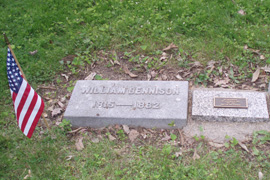
This is the grave of Gov. William N. Dennison, Ohio’s first Civil War-era governor. His son, Lt. William N. Dennison, a talented horse artillerist who served with the Army of the Potomac’s Cavalry Corps, is buried a few feet away.
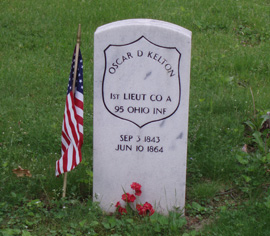
This is the grave of Lt. Oscar Kelton of the 95th Ohio Volunteer Infantry. The Kelton family was prominent in Nineteenth Century Columbus; the family home, which was a stop on the Underground Railroad, is a museum today. Lt. Kelton was KIA during Sherman’s Meridian Campaign in 1864. He was only 21 years old.
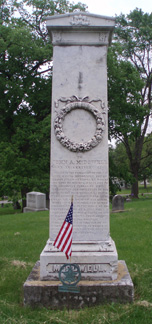
This is the grave of Maj. Gen. Irvin McDowell’s father, who was a War of 1812 veteran.
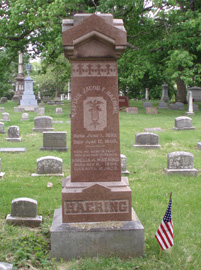
This is the grave of Jacob Haering, a Civil War veteran. I thought it was an extremely interesting monument, which is why I shot it. Note the GAR medal portrayed on the monument.

There are two sections of Civil War veterans. One of them includes a number of unknowns, as well as a number of United States Colored Troops, whose graves are interspersed among the the graves of the white soldiers who served alongside them. This is the grave of Pvt. Andy Grey, who served in the 15th U. S. Colored Infantry.

One of a number of unknown Union soldiers buried in the larger section.
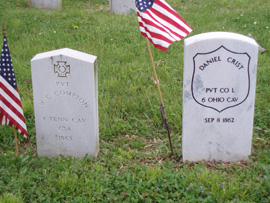
Brothers in arms, if not in service. Private Compton probably died at the Confederate prisoner of war prison site at Camp Chase.
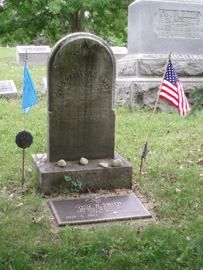
This is the grave of Ovid Wellford Smith, one of the Andrews Raiders, of Great Locomotive Chase fame. Like most of the raiders, Smith was awarded the Medal of Honor for his valor. His grave is the only one in the entire cemetery to have its own state historical marker.
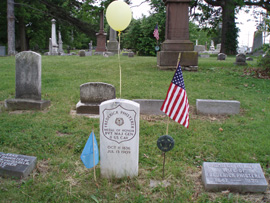
This is the grave of another Medal of Honor winner, Bvt. Maj. Gen. Frederick Phisterer. He was awarded the MOH as a First Lieutenant in the 18th U.S. Infantry for action on December 31, 1862 at Stone River, Tennessee. His citation reads “Voluntarily conveyed, under a heavy fire, information to the comander of a battalion of regular troops by which the battalion was saved from capture or annihilation.”
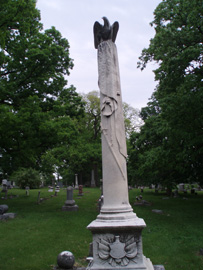
This is the grave marker of a young Union soldier who died of disease at Fortress Monroe in early 1864. The marker depicts a saber, the U.S. flag, an eagle on top, and a detail at the bottom showing a cannon tube, several rifles with bayonets, and several cavalry sabers. It’s without doubt one of the most interesting Civil War grave markers I’ve ever seen. And it belongs to a common soldier, which makes it even more interesting.
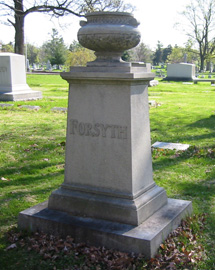
Thanks to Susan Forsyth for passing this one along. This is the grave of Brig. Gen. James William “Tony” Forsyth, Philip H. Sheridan’s chief of staff, who commanded the U. S. troops at the Wounded Knee episode in 1890. Forsyth was married to one of Governor Dennison’s daughters.
To all of our veterans, past, present, and future, thank you for your sacrifices in giving us the country that we enjoy today, and a special thank you to SSgt. Morton L. Wittenberg, 14th Air Force, who served in North Africa and Italy during World War II, and who shuffled off this mortal coil much too soon in December 1980.
Scridb filterAndy German on George D. Bayard
Notice: Use of undefined constant the_post_thumbnail - assumed 'the_post_thumbnail' in /home/netscrib/public_html/civilwarcavalry/wp-content/themes/wittenberg/archive.php on line 65

My old friend Andy German, who is THE authority on all things 1st Pennsylvania Cavalry, left a really outstanding comment to my post on George D. Bayard. So good, in fact, that I decided to feature it here:
Hello Eric,
I’m just catching up with your posts. It’s great to give Bayard his due. From my work on the 1st Pennsylvania Cavalry, he’s an old friend. It’s true that his volunteer troopers initially hated him for his strict discipline–and he knew that some had threatened to shoot him the first time they got to fire on the enemy–but after that first winter of instruction they had complete confidence in him. At a time when the federal cavalry in the east was trying to find its footing, he pushed his command and they met expectations. You mentioned the reconnaissance at Falmouth, which was actually a night attack to secure the bridge, thwarted by an ambush. At the end of May, Bayard’s “Flying Brigade” (which included a battalion of the “Bucktails” (riflemen) and a battery of mountain howitzers) reconnoitered far south of Fredericksburg, then immediately turned around and marched to the Valley, catching the end of Jackson’s column at Strasburg before Fremont’s command finished its much shorter march to complete the pincer movement. Then the cavalry led the federal advance through the rain, fighting aggressively with Jackson’s rear guard. You even see dismounted tactics employed here.
Under Pope, Bayard and Buford acted independently but supportively. Bayard’s fighting withdrawal from the Rapidan slowed Jackson’s advance by a day and permitted Pope to get into position at Cedar Mountain. There, Bayard sacrificed one battalion of his 1st Pennsylvania in a mounted charge against infantry. Later, as the Army of Virginia withdrew across the Rappahannock, Bayard conducted a successful mounted engagement with Confederate cavalry–a mini Brandy Station I. His troops then held Thorofare Gap against Longstreet and during Second Manassas maintained a cavalry presence on the left flank, prepared for a night cavalry charge in the center, and held the rear during the retreat to Centreville.
He remained in command of the cavalry in front of DC during the Antietam Campaign, but conducted scouts as far as Warrenton and proposed a mounted raid not unlike Stoneman’s Raid of six months later. As mentioned, his brigade joined the AoP at the beginning of November, and Pleasonton was not happy to be outranked by such a young officer. Bayard’s brigade performed well at Aldie, at Warrenton, and in the night seizure of the bridge at Rappahannock Station. At Fredericksburg, his brigade in the Left Grand Division was the only cavalry engaged. On the day before the battle they felt out the Confederate position and skirmished sharply with Confederate infantry along the railroad. After Pelham’s artillery flank attack, the 1st Pennsylvania was deployed to picket the left flank and sat on horseback all day under artillery fire. The rest of the brigade remained near Franklin’s headquarters, where Bayard was mortally wounded. It was speculated that a bolt from the Confederate Whitworth gun did the deed as the range was too great for conventional artillery. What a sad fluke.
Bayard’s death was a great loss, and his men found they missed his leadership greatly. They came to appreciate David Gregg’s fatherly leadership, and would do anything for him, but Gregg didn’t have the dash of Bayard. We can’t know for sure, but I’d say Bayard would have made a great division commander. His confidence in the mounted arm and comfort in independent command probably would have made him support the cavalry corps concept. Whether he would have suffered some of the fools in command and been able to manage the whole show is an intriguing question.
Thanks,
Andy German
Thanks for the input, Andy.
Scridb filterGood Luck to Tom Cartwright
Notice: Use of undefined constant the_post_thumbnail - assumed 'the_post_thumbnail' in /home/netscrib/public_html/civilwarcavalry/wp-content/themes/wittenberg/archive.php on line 65

Hat tip to Sam Hood for passing this article along.
The following article ran in today’s issue of the Williamson Herald newspaper:
Cartwright Resigns as Carter House Executive Director
By CAROLE ROBINSON, Staff Writer
crobinson@williamsonherald.comEven with the sounds of traffic passing along Columbia Avenue only 20 yards away, Thomas Cartwright manages to take Carter House visitors back in time to Nov. 30, 1864 and the bloodiest hours of the Battle of Franklin.
For those who have had Cartwright as their tour guide, or have heard him speak publicly, his knowledge, his passion and his love and respect for the warriors on both sides of the picket line, has made the battle and those who fought come alive to be remembered.
The job of telling the stories of Gen. Patrick Cleburne, Gen. John Bell Hood, the Carter family and “the bloodiest hours of the American Civil War,” will now fall to others.” Thomas Cartwright resigned his position as executive director of the historic Civil War house and museum earlier this week after more than 19 years.
“I have been offered some great opportunities doing some consulting,” Cartwright said. “This was not a snap decision. I thought about it. I prayed about it a long time. I love this site with all my heart–that will never change. I love working here–every afternoon at 4 o’clock I think of Capt. Tod Carter on his horse Rosencrantz saying,’I’m going home today.'”
He was mortally wounded just 525 feet from his home.
Opportunities to guide battlefield and historical tours across the country, including a Lewis and Clark tour and even in World War II European battlefield tours are also on the horizon for the 52-year-old historian.
Cartwright said he also looks forward to finishing his book, “The Mascots of the Civil War” and creating some non-historical books, such as a compilation of his collection of old animal photos from 1840 to the 1920s.
An ardent student of history, Cartwright was hired by the Carter House Board of Directors in January 1989 to identify artifacts and interpret the battle, the family, the town and the impact of the war. He became the museum’s military curator in April 1990 and executive director of the Carter House Nov. 7, 1997.
For him the job was so much more–it was a passion.
“Every day of my life I live the Battle of Franklin,” he said. “So many people have influenced my life, including Herbert Harper who saved the Carter House–it was going to be a gas station. I learned from the historians and the guests. If I’ve learned anything, I’ve learned it’s risky–dangerous–to judge the past with our eyes.”
A Nashville native, Cartwright’s interest in the Battle of Franklin began at a very early age when he listened to his grandmother tell stories of her father, who fought in the battle.
“I would love to sit with my grandparents and the old folks–aunts, uncles–and hear their stories over and over again; just stories about people. I think it’s important to know those personal stories– the human side and influence.”
When he was 5, he visited the McGavock cemetery (at Carnton).
“Afterwards, I remember riding by the Carter House and my mother pointed and said, ‘That’s where all the generals were killed.'”
On Nov. 30, 1964–he was 8–he joined his family in Franklin to celebrate the 100th anniversary of the Battle of Franklin and he recalls the impact of the guide putting a finger in the bullet hole in the family room of the Carter House. As Cartwright got older he tagged along with older boys on relic hunts for mini balls and cannon ball fragments in fields around Franklin and the soil of construction sites.
Since his mother worked for a publishing house, his appetite for history was all the more satiated when the owner would send him history books like “The Blue & The Gray.”
“While others were reading their comic books, I read history books,” he said. “I love all types of history. It’s the people–the personal stories that bring it alive. It’s important to honor them–to tell their stories and keep their memories alive–not glorify their deaths, but glorify their lives. Then we won’t repeat the same mistakes. On one aspect, I hate war and hurting other people, but the other aspect is the human side that captures me. I’m reminded of the quote, ‘In times of peace, sons bury their fathers. In times of war, fathers bury their sons.’ That typifies the Carter House. The Battle of Franklin demonstrated the best and the worst of mankind.”
During his 19 1/2 years at the Carter House, Cartwright said he continued learning through the many great historians he had the pleasure to meet and visitors who related their own family stories.
“So many people have been good to me and to the Carter House–I can’t name them all. I just hope a speck of their greatness has fallen on me so I can carry them with me. They are a part of my life and they will always be a part of my life. I’m the richest man of the face of the earth.”
Nancy Conway, who has been on the Carter House Board of Directors for more than 30 years, said Cartwright’s work has brought the site national, even international attention.
“It is not just what he did here, but the presence of Thomas across the United States that have identified Franklin, Tennessee, and the Carter House as significant Civil War sites,” Conway said.
Author Robert Hicks was with Cartwright on Monday and considers him a close friend.
“Thomas’s departure will leave a huge hole that nobody will really be able to fill for a long time in preservation,” Hicks said. “His passion for the Carter House and history is gigantic.”
Carter House Board of Directors President Shanon Wasielewski said the board is grateful for Cartwright’s 19 1/2 years of service.
“Thomas will be greatly missed. We appreciate everything he has given to the site and wish him the very best as he pursues his new opportunities,” Wasielewski said. “He has made an indelible mark on not only The Carter House, but on the interpretation of the Battle of Franklin and on those that have toured the house or had the fortune of hearing him speak during his tenure as executive director. Many people have been drawn to The Carter House because of Thomas Cartwright.” David Fraley, currently The Carter House historian and assistant curator, will serve as the interim executive director while the board is conducting a nationwide search for Cartwright’s replacement.
“We are fortunate to have someone like David who can help the organization through this transition,” Wasielewski said. “David brings a wealth of experience to the position as has hands on knowledge and expertise regarding The Carter House. He has served in key positions with the historic site for more than seven years.”
Posted on: 5/22/2008
Tom Cartwright has done a superb job of overseeing and preserving the Carter House, and he leaves with its land holdings being expanded and more of the Battle of Franklin’s battlefield protected than ever. He’s been a superb steward, and he will be missed in Franklin. Good luck to Tom with his new ventures.
Scridb filterI Don’t Get This….
Notice: Use of undefined constant the_post_thumbnail - assumed 'the_post_thumbnail' in /home/netscrib/public_html/civilwarcavalry/wp-content/themes/wittenberg/archive.php on line 65

Time for a rant. It’s been a while since the last one.
Google Book Search can be an extremely valuable resource. However, its usefulness can be severely limited by a practice that I REALLY don’t understand. More on that in a moment.
I remain as vehemently opposed to the concept of Google scanning works that are still covered by copyright as I have ever been. The flagrant disregard of intellectual property rights offends me deeply, and I will never support that aspect of the Google problem.
At the same time, the database of public domain materials is tremendously useful. I’ve made very extensive use of it, and I appreciate it. However, there is an aspect of the program that I just don’t get. There are a number of scanned works that I’ve encountered that can be looked at, but you can’t print them out, and you also cannot download them to your computer. They’re all in the public domain, so I cannot begin to understand what the rationale might be for such a moronic practice. Obviously, the library that owns the book has placed this idiotic restriction on the use of the material, and it infuriates me to no end. Where the book is in the public domain, there simply is NO justification for such an idiotic policy.
It’s akin to dangling a bottle of whiskey in front of an alcoholic and then expecting that alcoholic to not take a drink from that bottle. There is no justification for teasing a researcher like that. It leaves the work almost useless, and I’ve had just about enough of it.
Sorry for the rant, but I needed to get that off my chest.
Scridb filterNotice: Undefined index: id in /home/netscrib/public_html/civilwarcavalry/wp-content/themes/wittenberg/footer.php on line 8
Notice: Undefined index: id in /home/netscrib/public_html/civilwarcavalry/wp-content/themes/wittenberg/footer.php on line 8
Notice: Undefined index: std in /home/netscrib/public_html/civilwarcavalry/wp-content/themes/wittenberg/footer.php on line 8
Notice: Undefined index: id in /home/netscrib/public_html/civilwarcavalry/wp-content/themes/wittenberg/footer.php on line 8
Notice: Undefined index: id in /home/netscrib/public_html/civilwarcavalry/wp-content/themes/wittenberg/footer.php on line 8
Notice: Undefined index: std in /home/netscrib/public_html/civilwarcavalry/wp-content/themes/wittenberg/footer.php on line 8
Notice: Undefined index: id in /home/netscrib/public_html/civilwarcavalry/wp-content/themes/wittenberg/footer.php on line 8
Notice: Undefined index: id in /home/netscrib/public_html/civilwarcavalry/wp-content/themes/wittenberg/footer.php on line 8
Notice: Undefined index: std in /home/netscrib/public_html/civilwarcavalry/wp-content/themes/wittenberg/footer.php on line 8
Notice: Undefined index: id in /home/netscrib/public_html/civilwarcavalry/wp-content/themes/wittenberg/footer.php on line 8
Notice: Undefined index: id in /home/netscrib/public_html/civilwarcavalry/wp-content/themes/wittenberg/footer.php on line 8
Notice: Undefined index: std in /home/netscrib/public_html/civilwarcavalry/wp-content/themes/wittenberg/footer.php on line 8
Notice: Undefined index: id in /home/netscrib/public_html/civilwarcavalry/wp-content/themes/wittenberg/footer.php on line 8
Notice: Undefined index: id in /home/netscrib/public_html/civilwarcavalry/wp-content/themes/wittenberg/footer.php on line 8
Notice: Undefined index: std in /home/netscrib/public_html/civilwarcavalry/wp-content/themes/wittenberg/footer.php on line 8
Notice: Undefined index: id in /home/netscrib/public_html/civilwarcavalry/wp-content/themes/wittenberg/footer.php on line 8
Notice: Undefined index: id in /home/netscrib/public_html/civilwarcavalry/wp-content/themes/wittenberg/footer.php on line 8
Notice: Undefined index: std in /home/netscrib/public_html/civilwarcavalry/wp-content/themes/wittenberg/footer.php on line 8
Notice: Undefined index: id in /home/netscrib/public_html/civilwarcavalry/wp-content/themes/wittenberg/footer.php on line 8
Notice: Undefined index: id in /home/netscrib/public_html/civilwarcavalry/wp-content/themes/wittenberg/footer.php on line 8
Notice: Undefined index: std in /home/netscrib/public_html/civilwarcavalry/wp-content/themes/wittenberg/footer.php on line 8
Notice: Undefined index: id in /home/netscrib/public_html/civilwarcavalry/wp-content/themes/wittenberg/footer.php on line 8
Notice: Undefined index: id in /home/netscrib/public_html/civilwarcavalry/wp-content/themes/wittenberg/footer.php on line 8
Notice: Undefined index: std in /home/netscrib/public_html/civilwarcavalry/wp-content/themes/wittenberg/footer.php on line 8
Notice: Undefined index: id in /home/netscrib/public_html/civilwarcavalry/wp-content/themes/wittenberg/footer.php on line 8
Notice: Undefined index: id in /home/netscrib/public_html/civilwarcavalry/wp-content/themes/wittenberg/footer.php on line 8
Notice: Undefined index: std in /home/netscrib/public_html/civilwarcavalry/wp-content/themes/wittenberg/footer.php on line 8
Notice: Undefined index: id in /home/netscrib/public_html/civilwarcavalry/wp-content/themes/wittenberg/footer.php on line 8
Notice: Undefined index: id in /home/netscrib/public_html/civilwarcavalry/wp-content/themes/wittenberg/footer.php on line 8
Notice: Undefined index: std in /home/netscrib/public_html/civilwarcavalry/wp-content/themes/wittenberg/footer.php on line 8
Notice: Undefined index: id in /home/netscrib/public_html/civilwarcavalry/wp-content/themes/wittenberg/footer.php on line 8
Notice: Undefined index: id in /home/netscrib/public_html/civilwarcavalry/wp-content/themes/wittenberg/footer.php on line 8
Notice: Undefined index: std in /home/netscrib/public_html/civilwarcavalry/wp-content/themes/wittenberg/footer.php on line 8
Notice: Undefined index: id in /home/netscrib/public_html/civilwarcavalry/wp-content/themes/wittenberg/footer.php on line 8
Notice: Undefined index: id in /home/netscrib/public_html/civilwarcavalry/wp-content/themes/wittenberg/footer.php on line 8
Notice: Undefined index: std in /home/netscrib/public_html/civilwarcavalry/wp-content/themes/wittenberg/footer.php on line 8
Notice: Undefined index: id in /home/netscrib/public_html/civilwarcavalry/wp-content/themes/wittenberg/footer.php on line 8
Notice: Undefined index: id in /home/netscrib/public_html/civilwarcavalry/wp-content/themes/wittenberg/footer.php on line 8
Notice: Undefined index: std in /home/netscrib/public_html/civilwarcavalry/wp-content/themes/wittenberg/footer.php on line 8
Notice: Undefined index: id in /home/netscrib/public_html/civilwarcavalry/wp-content/themes/wittenberg/footer.php on line 8
Notice: Undefined index: id in /home/netscrib/public_html/civilwarcavalry/wp-content/themes/wittenberg/footer.php on line 8
Notice: Undefined index: std in /home/netscrib/public_html/civilwarcavalry/wp-content/themes/wittenberg/footer.php on line 8
Notice: Undefined index: id in /home/netscrib/public_html/civilwarcavalry/wp-content/themes/wittenberg/footer.php on line 8
Notice: Undefined index: id in /home/netscrib/public_html/civilwarcavalry/wp-content/themes/wittenberg/footer.php on line 8
Notice: Undefined index: std in /home/netscrib/public_html/civilwarcavalry/wp-content/themes/wittenberg/footer.php on line 8
Notice: Undefined index: id in /home/netscrib/public_html/civilwarcavalry/wp-content/themes/wittenberg/footer.php on line 8
Notice: Undefined index: id in /home/netscrib/public_html/civilwarcavalry/wp-content/themes/wittenberg/footer.php on line 8
Notice: Undefined index: std in /home/netscrib/public_html/civilwarcavalry/wp-content/themes/wittenberg/footer.php on line 8
Notice: Undefined index: id in /home/netscrib/public_html/civilwarcavalry/wp-content/themes/wittenberg/footer.php on line 8
Notice: Undefined index: id in /home/netscrib/public_html/civilwarcavalry/wp-content/themes/wittenberg/footer.php on line 8
Notice: Undefined index: std in /home/netscrib/public_html/civilwarcavalry/wp-content/themes/wittenberg/footer.php on line 8
Notice: Undefined index: id in /home/netscrib/public_html/civilwarcavalry/wp-content/themes/wittenberg/footer.php on line 8
Notice: Undefined index: id in /home/netscrib/public_html/civilwarcavalry/wp-content/themes/wittenberg/footer.php on line 8
Notice: Undefined index: std in /home/netscrib/public_html/civilwarcavalry/wp-content/themes/wittenberg/footer.php on line 8
Notice: Undefined index: id in /home/netscrib/public_html/civilwarcavalry/wp-content/themes/wittenberg/footer.php on line 8
Notice: Undefined index: id in /home/netscrib/public_html/civilwarcavalry/wp-content/themes/wittenberg/footer.php on line 8
Notice: Undefined index: std in /home/netscrib/public_html/civilwarcavalry/wp-content/themes/wittenberg/footer.php on line 8
Notice: Undefined index: id in /home/netscrib/public_html/civilwarcavalry/wp-content/themes/wittenberg/footer.php on line 8
Notice: Undefined index: id in /home/netscrib/public_html/civilwarcavalry/wp-content/themes/wittenberg/footer.php on line 8
Notice: Undefined index: std in /home/netscrib/public_html/civilwarcavalry/wp-content/themes/wittenberg/footer.php on line 8
Notice: Undefined index: id in /home/netscrib/public_html/civilwarcavalry/wp-content/themes/wittenberg/footer.php on line 8
Notice: Undefined index: id in /home/netscrib/public_html/civilwarcavalry/wp-content/themes/wittenberg/footer.php on line 8
Notice: Undefined index: std in /home/netscrib/public_html/civilwarcavalry/wp-content/themes/wittenberg/footer.php on line 8








 Back to top
Back to top Blogs I like
Blogs I like 